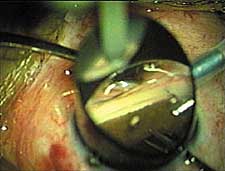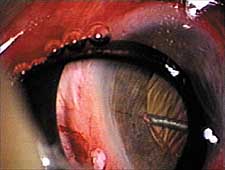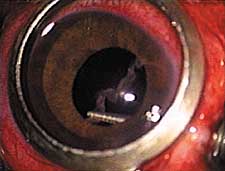Ab interno angle surgery for glaucoma improves safety and efficacy
The angle is opened by iris root traction and then cleared of obstructing materials.
ROME — Ab interno angle surgery is a safe and effective procedure in most cases of closed angle glaucoma, according to one surgeon.
“It is thanks to viscoelastic substances and especially to the instruments of vitreoretinal surgery that we can now operate safely on the angle under microscopic vision. It seems like ages since I stopped using filtering surgery in closed angle glaucoma. I simply open the angle using iris root traction and clean it of cyclitic membranes, synechiae, tamponade remnants or whatever else needs to be removed, entering through the limbus or through the pars plana,” said Vito De Molfetta, MD, head of the San Gerardo eye clinic in Monza, Italy, speaking at Rome 2001.
|
|
Limbal access is preferred when treating phakic patients, as well as in combination with cataract surgery, while the pars plana approach is used in aphakic eyes and with phacoaspiration, vitrectomy or silicone oil removal.
Indications for this surgery are all types of secondary glaucoma, but also certain cases of primary glaucoma.
Perfect visualization of the angle
In phakic patients, the procedure is initiated by inducing miosis to stretch the angle and to protect the lens. An infusion cannula is then inserted into the anterior chamber.
“The infusion cannula is not strictly necessary, but I would recommend it in order to have a deep and stable anterior chamber,” Prof. De Molfetta said.
At this point, viscoelastic is injected with a 30 gauge needle. The viscoelastic is absolutely essential to make maneuvers safe and comfortable, to control bleeding and to prevent postoperative loss of the anterior chamber.
“Use a high-viscosity, cohesive viscoelastic to maintain a deep chamber and to prevent substance dispersion in the angle,” he said.
Peripheral indentation is then performed. This maneuver allows a perfect gonioscopic visualization of the angle structures.
“You can see exactly where the alterations are, how they appear and how far they are extended,” he said.
A limbal incision is then performed.
“You can even make your access in clear cornea. Use a 20 gauge spear or a 30 gauge needle, depending on the maneuvers you want to perform later.”
Angle clearance
“Through the limbal incision, you can now introduce all the instruments you need to open the angle and clear it of whatever encumbrances are there. Using endodiathermiae, you can close new blood vessels in neovascular glaucoma. With microaspirators, you can remove blood or silicone residuals in secondary glaucoma. Vitreous forceps may be used to remove membranes and to open the iris root. Vitreous spatulas and diamond knives can remove synechiae,” Prof. De Molfetta said.
After this “goniocosmesis” procedure has been completed, nylon sutures are applied to close the access.
When entering through the pars plana, the stages of surgery are basically the same. Pars plana vitrectomy can be performed through the same access, following standard procedures. Phacoaspiration and removal of silicone oil residuals may also be performed at the same time.
The success rate of the procedure is very high, and results are excellent, according to Prof. Molfetta.
“You can open angles that have been closed for over a year. The aqueous outflow is immediate, and, after 1 day, intraocular pressure is reduced to normal values,” he said.
“Complications are very rare,” he added. “In good hands, intraoperative problems are reduced to occasional hemorrhages, which are easily controlled by the viscoelastic. Postoperatively, there might be cases of hypotony, but they are only temporary, and stable IOP values are reached within a few days.”
For Your Information:
- Vito De Molfetta, MD, can be reached at Ospedale San Gerardo, Clinica Oculistica, Monza, Italy; (39) 039-2334726; fax: (39) 039-2334777.
- Rome 2001, the Rome Symposium on Cataract, Glaucoma and Refractive Surgery, was co-sponsored by Ocular Surgery News Europe/Asia-Pacific Edition, The Italian Association of Cataract and Refractive Surgery and the International Society of Refractive Surgery. For information on future meetings, contact Meeting Registration at (856) 848-1000.



